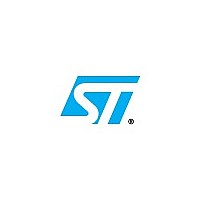ST92150CV1Q-Auto STMicroelectronics, ST92150CV1Q-Auto Datasheet - Page 115

ST92150CV1Q-Auto
Manufacturer Part Number
ST92150CV1Q-Auto
Description
8-bit MCU for automotive
Manufacturer
STMicroelectronics
Datasheet
1.ST92150JDV1QAUTO.pdf
(430 pages)
Specifications of ST92150CV1Q-Auto
Internal Memory
Single Voltage FLASH up to 256 Kbytes, RAM up to 8Kbytes, 1K byte E3 TM (Emulated EEPROM)
Minimum Instruction Time
83 ns (24 MHz int. clock)
- Current page: 115 of 430
- Download datasheet (7Mb)
WAKE-UP / INTERRUPT LINES MANAGEMENT UNIT (Cont’d)
Case 3: NMI = 1 (NMI kept high during the 3rd
write instruction of the sequence), bad STOP
bit setting sequence
The result is the same as Case 1:
This means that the ST9 did not enter STOP mode
due to a bad STOP bit setting sequence: the user
must retry the sequence.
Case 4: NMI = 1 (NMI kept high during the 3rd
write instruction of the sequence), correct
STOP bit setting sequence
In this case:
This means that the ST9 did not enter STOP mode
due to NMI being kept high. The user should clear
the STOP bit via software.
Note: If NMI goes to 0 before resetting the STOP
bit, the ST9 will not enter STOP mode.
Case 5: A rising edge on the NMI pin occurs
during the STOP bit setting sequence.
The NMI interrupt will be acknowledged and the
ST9 will not enter STOP mode. This implies:
This means that the ST9 did not enter STOP mode
due to an NMI interrupt serviced during the STOP
bit setting sequence. At the end of NMI routine, the
user must re-enter the sequence: if NMI is still high
at the end of the sequence, the ST9 can not enter
STOP mode (See “NMI Pin Management” on
page 116.).
Case 6: A wake-up event on the external wake-
up lines occurs during the STOP bit setting se-
quence
There are two possible cases:
1. Interrupt requests to the CPU are disabled: in
this case the ST9 will not enter STOP mode, no
interrupt service routine will be executed and
the program execution continues from the
instruction following the STOP bit setting
sequence. The status of STOP and EX_STP
bits will be again:
STOP = 0, EX_STP = 0
STOP = 1, EX_STP = 0
STOP = 0, EX_STP = 0
ST92124xxx-Auto/150xxxxx-Auto/250xxxx-Auto
2. Interrupt requests to CPU are enabled: in this
If the MCU really exits from STOP Mode, the
RCCU EX_STP bit is still set and must be reset by
software. Otherwise, if NMI was high or an Inter-
rupt/DMA request was acknowledged during the
STOP bit setting sequence, the RCCU EX_STP bit
is reset. This means that the MCU has filtered the
STOP Mode entry request.
The WKUP-INT bit can be used by an interrupt
routine to detect and to distinguish events coming
from Interrupt Mode or from Wake-up Mode, allow-
ing the code to execute different procedures.
To exit STOP mode, it is sufficient that one of the
16 wake-up lines (not masked) generates an
event: the clock restarts after the delay needed for
the oscillator to restart.
The same effect is obtained when a rising edge is
detected on the NMI pin, which works as a 17th
wake-up line.
Note: After exiting from STOP Mode, the software
can successfully reset the pending bits (edge sen-
sitive), even though the corresponding wake-up
line is still active (high or low, depending on the
Trigger Event register programming); the user
must poll the external pin status to detect and dis-
tinguish a short event from a long one (for example
keyboard input with keystrokes of varying length).
The application can determine why the ST9 did
not enter STOP mode by polling the pending
bits of the external lines (at least one must be at
1).
case the ST9 will not enter STOP mode and the
interrupt service routine will be executed. The
status of STOP and EX_STP bits will be again:
The interrupt service routine can determine why
the ST9 did not enter STOP mode by polling
the pending bits of the external lines (at least
one must be at 1).
STOP = 0, EX_STP = 0
STOP = 0, EX_STP = 0
115/430
9
Related parts for ST92150CV1Q-Auto
Image
Part Number
Description
Manufacturer
Datasheet
Request
R

Part Number:
Description:
8/16-BIT SINGLE VOLTAGE FLASH MCU FAMILY WITH RAM / E3 TMEMULATED EEPROM / CAN 2.0B AND J1850 BLPD
Manufacturer:
ST Microelectronics
Datasheet:

Part Number:
Description:
STMicroelectronics [RIPPLE-CARRY BINARY COUNTER/DIVIDERS]
Manufacturer:
STMicroelectronics
Datasheet:

Part Number:
Description:
STMicroelectronics [LIQUID-CRYSTAL DISPLAY DRIVERS]
Manufacturer:
STMicroelectronics
Datasheet:

Part Number:
Description:
BOARD EVAL FOR MEMS SENSORS
Manufacturer:
STMicroelectronics
Datasheet:

Part Number:
Description:
NPN TRANSISTOR POWER MODULE
Manufacturer:
STMicroelectronics
Datasheet:

Part Number:
Description:
TURBOSWITCH ULTRA-FAST HIGH VOLTAGE DIODE
Manufacturer:
STMicroelectronics
Datasheet:

Part Number:
Description:
Manufacturer:
STMicroelectronics
Datasheet:

Part Number:
Description:
DIODE / SCR MODULE
Manufacturer:
STMicroelectronics
Datasheet:

Part Number:
Description:
DIODE / SCR MODULE
Manufacturer:
STMicroelectronics
Datasheet:

Part Number:
Description:
Search -----> STE16N100
Manufacturer:
STMicroelectronics
Datasheet:

Part Number:
Description:
Search ---> STE53NA50
Manufacturer:
STMicroelectronics
Datasheet:

Part Number:
Description:
NPN Transistor Power Module
Manufacturer:
STMicroelectronics
Datasheet:










